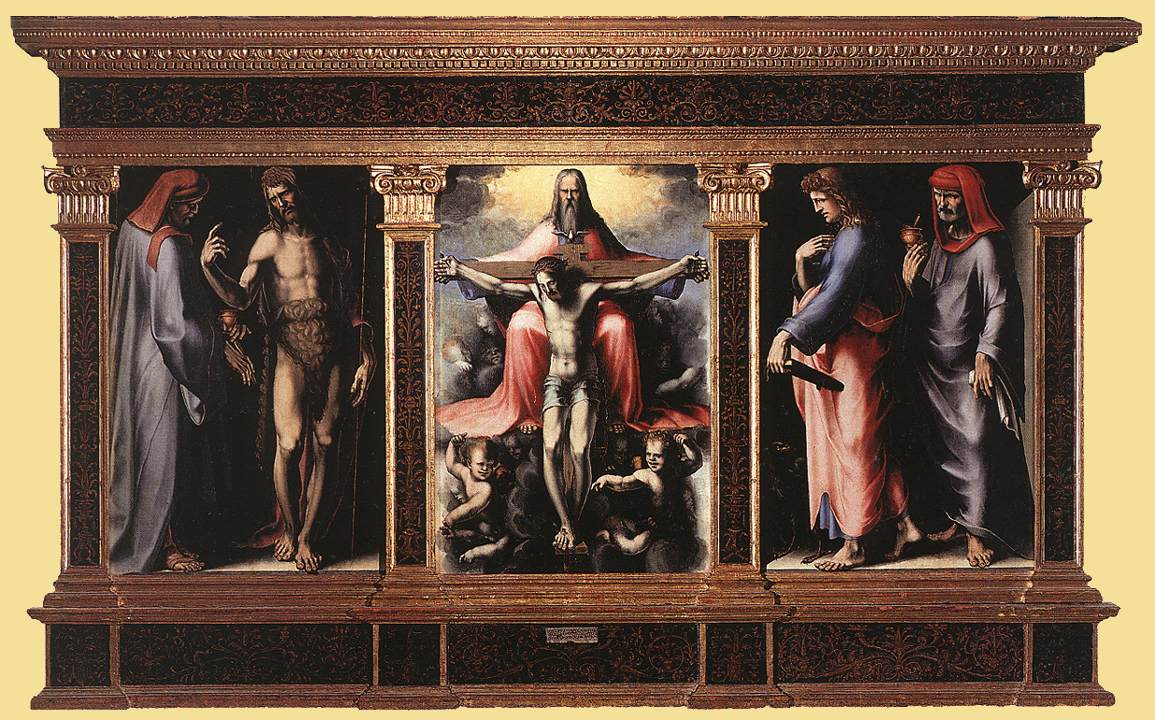Trinity Triptych on:
[Wikipedia]
[Google]
[Amazon]
 The Trinity Triptych is a 1513 oil-on-panel painting by the Italian
The Trinity Triptych is a 1513 oil-on-panel painting by the Italian
 The Trinity Triptych is a 1513 oil-on-panel painting by the Italian
The Trinity Triptych is a 1513 oil-on-panel painting by the Italian Mannerist
Mannerism is a style in European art that emerged in the later years of the Italian High Renaissance around 1520, spreading by about 1530 and lasting until about the end of the 16th century in Italy, when the Baroque style largely replaced it ...
painter Domenico Beccafumi, now in the Pinacoteca Nazionale in Siena
Siena ( , ; traditionally spelled Sienna in English; ) is a city in Tuscany, in central Italy, and the capital of the province of Siena. It is the twelfth most populated city in the region by number of inhabitants, with a population of 52,991 ...
.
Beccafumi's earliest surviving painting, it was produced as the altarpiece for the Cappella del Manto in the Santa Maria della Scala hospital complex, where it remained until 1818. This influenced the choice of Cosmas and Damian
Cosmas and Damian ( – or AD) were two Arab physicians and early Christian martyrs. They practised their profession in the seaport of Aegeae, then in the Roman province of Cilicia.
Cosmas and Damian were third century Arabian-born twin ...
as two of the accompanying saints, flanking John the Baptist
John the Baptist ( – ) was a Jewish preacher active in the area of the Jordan River in the early first century AD. He is also known as Saint John the Forerunner in Eastern Orthodoxy and Oriental Orthodoxy, John the Immerser in some Baptist ...
and John the Evangelist
John the Evangelist ( – ) is the name traditionally given to the author of the Gospel of John. Christians have traditionally identified him with John the Apostle, John of Patmos, and John the Presbyter, although there is no consensus on how ...
. The artist also produced a fresco cycle for that chapel, of which only ''Joachim and Anna Meeting at the Golden Gate'' survives.
A prestigious work in light of the commissioning institution's importance and wealth, it showed Beccafumi's welcome back to Siena (he had just returned from Rome at the time). A cartouche on the frame records the work was commissioned by Battista d'Antonio da Ceva "for his devotion . As shown in documents rediscovered by Samminiatelli, the work was delivered during February and March 1513 at a fee no greater than 35 florin
The Florentine florin was a gold coin (in Italian ''Fiorino d'oro'') struck from 1252 to 1533 with no significant change in its design or metal content standard during that time.
It had 54 grains () of nominally pure or 'fine' gold with a pu ...
s. Vasari's ''Lives of the Artists
''The Lives of the Most Excellent Painters, Sculptors, and Architects'' () is a series of artist biographies written by 16th-century Italian painter and architect Giorgio Vasari, which is considered "perhaps the most famous, and even today the ...
'' argued the work's main influence was Perugino
Pietro Perugino ( ; ; born Pietro Vannucci or Pietro Vanucci; – 1523), an Italian Renaissance painter of the Umbrian school, developed some of the qualities that found classic expression in the High Renaissance. Raphael became his most famous ...
but in fact that the artist's influence was absent in favour of Sienese and Florentine art of the period, particularly Fra' Bartolomeo's simplification of volume, Sodoma's fluidity and Filippino Lippi
Filippino Lippi (probably 1457 – 18 April 1504) was an Italian Renaissance painter mostly working in Florence, Italy during the later years of the Early Renaissance and first few years of the High Renaissance. He also worked in Rome for a ...
's expressive restlessness. The cherubs in cloud recall Raphael
Raffaello Sanzio da Urbino (; March 28 or April 6, 1483April 6, 1520), now generally known in English as Raphael ( , ), was an Italian painter and architect of the High Renaissance. List of paintings by Raphael, His work is admired for its cl ...
's recent Foligno Madonna, which Beccafumi may have seen in Rome as a work in progress, while the restlessly moving and individualised figures and contrasting colours both prefigure Mannerism
Mannerism is a style in European art that emerged in the later years of the Italian High Renaissance around 1520, spreading by about 1530 and lasting until about the end of the 16th century in Italy, when the Baroque style largely replaced it ...
. Alfredo Aldrovandi, Nicoletta Bracci, Paola Bracco, Ciro Castelli, Ottavio Ciappi, Marco Ciatti, Mauro Parri, Alessandra Ramat and Andrea Santacesaria, 'Ricerche e Interventi su Alcuni Dipinti di Domenico Beccafumi', ''OPD Restauro'', No. 4 (1992), pp. 28-50, 99-104
References